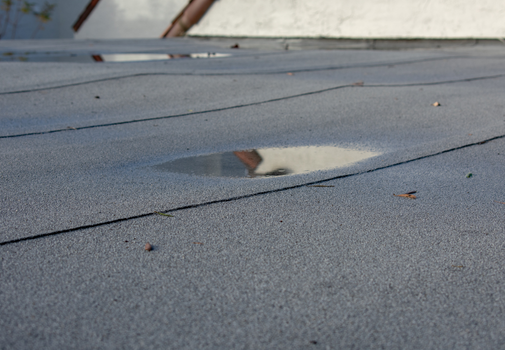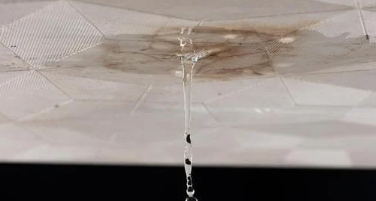How To Fix Pooling Water On The Roof?

Is your roof holding water longer than it should after it rains? If you’ve noticed puddles forming in the same spots again and again, you might be dealing with pooling water on a flat roof. This can lead to leaks, mold, and serious damage if not addressed quickly.
In this blog, we’ll explain what causes ponding water, why it’s a problem for Florida homeowners, and give you easy-to-understand flat roof water drainage solutions. Whether you’re trying to learn how to fix roof ponding or just want to know how to prevent it, this guide is for you.
What Is Pooling or Ponding Water?

Pooling water (also known as ponding water) happens when water stays on the surface of your roof for more than 48 hours after it rains. While flat roofs aren’t perfectly flat, they’re slightly sloped. Drainage problems or poor designs can stop water from flowing off the roof like it should.
Why Pooling Water is a Problem
- It adds extra weight to your roof structure, which can stress beams and supports over time, potentially leading to sagging or collapse in severe cases.
- Water can slowly leak through cracks or seams in the roofing membrane, causing damage to insulation, ceilings, and interior walls, often before you even see visible signs.
- Increases chances of mold, rot, and mildew, which can affect your health and require costly remediation efforts if left unchecked.
- Attracts insects and pests, like mosquitoes and termites, that thrive in damp environments and can cause secondary issues in and around your home.
- Shortens the life of roofing materials by accelerating wear and tear, particularly in areas with constant moisture exposure and UV damage.
If your home is in a high-rainfall area like Naples or Southwest Florida, ponding water can be especially dangerous.
Common Causes of Roof Water Pooling
Knowing what causes ponding is the first step toward a solution. Here are the most common causes of roof drainage problems to consider:
1. Poor Roof Slope
A flat roof may look level, but it should have a slight slope to allow water to drain off properly. If the slope is too shallow or has settled unevenly over time, water can accumulate in low-lying areas. This is especially common in older buildings or poorly designed roofs.
2. Blocked Drains or Scuppers
Drains, gutters, and scuppers are responsible for channeling water off your roof. When these outlets become clogged with leaves, dirt, or roofing debris, they can’t do their job effectively. As a result, water gets stuck on the surface and starts to pool in certain areas, especially after heavy rainfall.
3. Sagging or Structural Issues
Over time, roofs may develop dips or sagging areas due to age, water damage, or insufficient support underneath. These sagging sections create pockets where water naturally collects. This often gets worse if the underlying structure has rotted or weakened due to previous water exposure.
4. Roofing Material Problems
Even if the slope and drainage are fine, worn-out or damaged roofing materials can contribute to water retention. Cracks, soft spots, blistering, or bubbles in the membrane can trap water or prevent it from flowing as it should. Some low-quality roofing materials are more prone to these issues in Florida’s hot, humid weather.
Understanding the root cause of water pooling is crucial for finding the right solution, whether it’s a simple repair or a complete roofing upgrade.
How to Fix Pooling Water on a Flat Roof
If you’re facing recurring puddles on your flat roof, here are some practical flat roof water pooling fix options. Always consider working with a licensed roofing contractor like King Roofing to ensure long-lasting repairs.
1. Install Tapered Insulation
Adding tapered insulation is a great way to fix drainage issues without fully replacing your roof. This material is installed in a way that forms a gradual slope, helping direct water toward existing drains. It’s lightweight, energy-efficient, and compatible with most roofing systems.
2. Add or Replace Drains
Your flat roof might simply need more drainage points. A contractor can assess the layout and recommend adding interior drains, scuppers, or even wider gutters. Improving or replacing older drains can also improve flow and stop water from backing up.
3. Use Roof Coatings
Silicone or elastomeric coatings offer a layer of waterproof protection and help smooth out uneven surfaces. These coatings not only help resist UV damage but also fill in small dips and imperfections where water tends to collect. This is a more affordable option for minor ponding.
4. Re-Pitch the Roof
When pooling is caused by larger structural issues or incorrect design, the roof may need to be re-pitched. This is a more involved solution that can involve rebuilding sections of the roof to ensure proper slope. It’s a bigger investment, but it solves the problem for the long term.
5. Install Crickets or Saddles
Crickets or saddles are small raised sections that direct water away from trouble spots like vents, chimneys, and skylights. These features work well when water tends to collect in specific areas rather than across the entire roof.
6. Repair or Replace Damaged Roofing Membrane
If your roofing membrane has blisters, tears, or is aging, it may need to be patched or replaced. A new membrane with a built-in slope can be applied to help redirect water more effectively while giving your roof a longer lifespan.
7. Upgrade to a More Resilient Roofing System
For homes with ongoing ponding issues, it might be time to consider upgrading to a modern flat roofing system designed for better water management. Options include modified bitumen with advanced drainage design or single-ply systems like TPO with reflective, heat-resistant features.
Common Homeowner Mistakes to Avoid
Even the most proactive homeowners can unknowingly make mistakes that make ponding water worse. Avoid these common issues to protect your roof:
1. Putting Off Maintenance
Delaying regular roof inspections or ignoring small drainage issues can lead to long-term damage and costly repairs.
2. Failing to Clean Roof Drains
If drains or scuppers are clogged, water won’t have anywhere to go. Always clear out leaves, twigs, and dirt after storms.
3. Applying DIY Fixes Without Understanding the Slope
Using coatings or patches without adjusting the roof’s pitch can trap more water instead of solving the issue.
4. Walking on Ponding Areas
Walking over soft or sunken parts of the roof can cause tears or additional sagging.
5. Hiring Unlicensed Contractors
Choosing cheap, unlicensed labor may result in poorly installed drainage or membrane repairs that fail under pressure.
How To Prevent Pooling Water From Coming Back
Preventing future water buildup is just as important as fixing the problem. Here are tips to keep your roof dry and problem-free:
1. Schedule Regular Roof Inspections
Have a professional inspect your roof twice a year and after major storms. They’ll catch small issues before they become big problems.
2. Clean Your Drains & Gutters
This simple step goes a long way in maintaining proper drainage and avoiding clogs.
3. Use High-Quality Roofing Materials
Investing in good roofing materials can save money long-term by reducing repairs and extending the roof’s life.
4. Monitor Roof After Heavy Rains
Check your roof (safely or via a professional) to spot pooling areas and take action quickly.
5. Hire a Licensed Roofing Contractor
Always choose licensed, insured professionals who know local codes and climate challenges, especially in Florida.
Get A Free Roof Inspection Today
If you’re tired of worrying about pooling water on your flat roof, let King Roofing help. We’ve been protecting homes in Naples and Southwest Florida for over 45 years. Our team will inspect your roof, explain your options, and recommend the best long-term flat roof water pooling fix.
- Free roof inspection
- Expert evaluation of roof drainage problems and solutions
- 5-year transferable workmanship warranty on all new roofs
Don’t wait until a leak damages your home. Contact King Roofing today for your free estimate.
FAQs: Flat Roof Ponding Water Fixes
Q: Can I fix roof ponding myself?
A: You might be able to clear debris or apply temporary coatings, but most long-term fixes require a professional to assess the structural integrity and ensure proper drainage design.
Q: Is ponding water covered by homeowners insurance?
A: Sometimes. Insurance may cover water damage if it results from a sudden, covered event like a storm. However, gradual damage caused by neglect or lack of maintenance is usually not covered. It’s best to review your policy or speak with your insurance agent for clarity.
Q: How long does it take to fix pooling water?
A: Minor fixes, like clearing debris or applying a roof coating, might take a few hours. More complex solutions, such as adding drains, installing tapered insulation, or re-pitching the roof, can take several days depending on the roof size and severity of the issue.
Q: What’s the cost to fix ponding water on a flat roof?
A: The cost can range from a few hundred dollars for small repairs to several thousand for structural work or a full roof upgrade. Getting a professional estimate will provide a better understanding of the best and most cost-effective solution.












